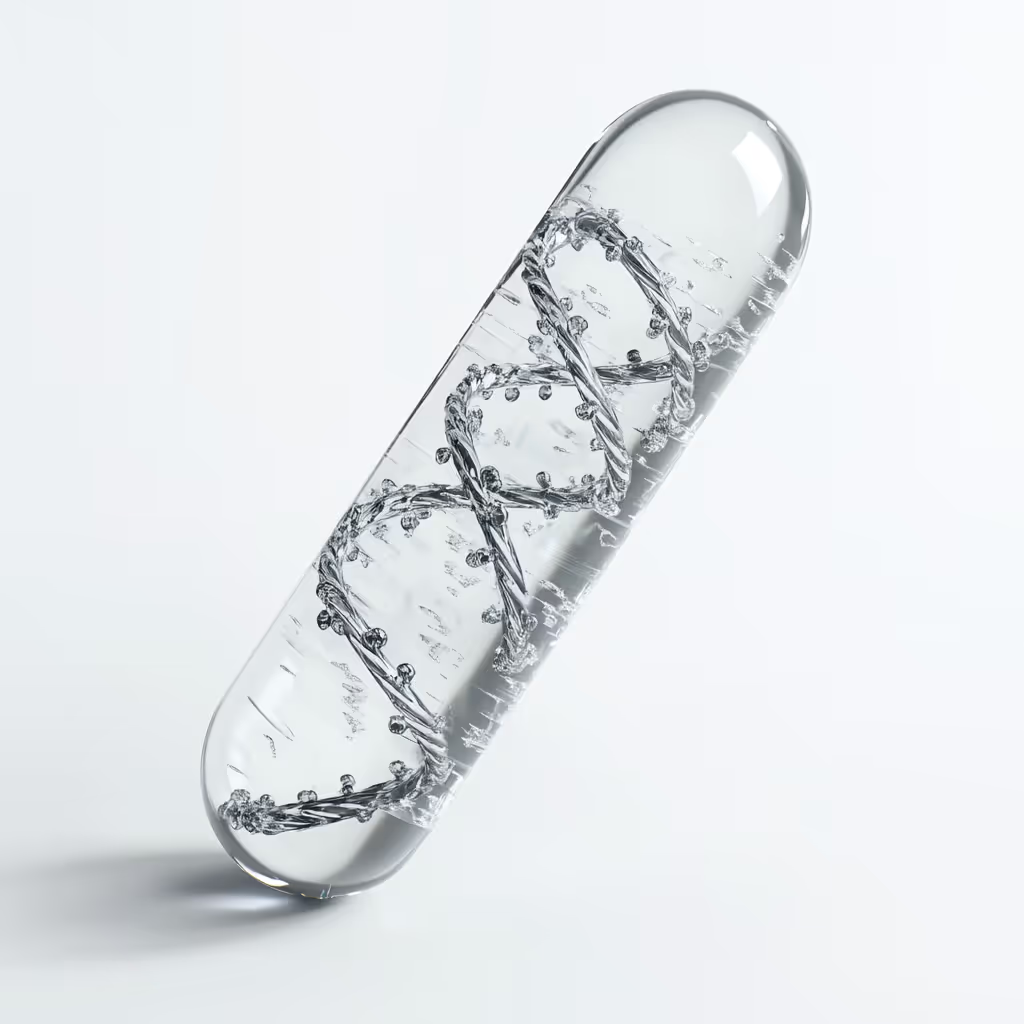
There's an enormous amount of hype in the longevity space.
I (Chris) want to live a long life and extend my healthspan as far and as deeply into it as I can, so I really want to find the genuine scientific principles that lie buried in all this hype.
That's why I developed Mitome: it's an at-home test that measures how efficiently your mitochondria convert nutrients into cellular energy. Why does this matter more than other longevity markers? Because mitochondrial function is the one thing that suffers the worst during aging that happens to fuel every protective anti-aging process you need to maximize your health span and carry it forward as long as your genetic limits allow.
Here are a few ideas I just can't buy:
- Calorie restriction. When 42 strains of mice were compared, whether calorie restriction made them live longer or shorter was totally dependent on their strain. More mouse strains had their lifespans cut by calorie restriction than had them lengthened. If we can't generalize from one mouse strain to another, we certainly shouldn't be generalizing from mice to humans.
- Rapamycin. Rapamycin lengthens life in mice, but in the very same mice whose lives are lengthened, it gives them testicular atrophy, cataracts, fatty liver, impaired glucose metabolism, and fibrosis in their hearts. There is no dose of rapamycin that lengthens the lifespan of mice without destroying their healthspan.
- Protein restriction. Protein is needed to protect against the loss of muscle (sarcopenia) and bone (osteopenia and osteoporosis) that occurs with age, protects against diabetes, a major killer, and is needed to detoxify carcinogens that cause cancer, the major killer once you are in the clear from heart disease. By protecting against sarcopenia, osteopenia, and osteoporosis, protein helps clear out the 70% mortality rate that occurs in the year following a hip fracture. The argument against protein per se focuses on the growth factor IGF-1. But IGF-1 has its clearest association with body mass and the best way to avoid excessive IGF-1 is to avoid obesity. Protein actually helps with that. Animal experiments show that once you have cancer, protein promotes its growth. But they also show that lifelong consumption of protein protects against cancer because detoxifying carcinogens is more important than protecting against cancer growth if you don't already have a diagnosis.
- Methionine restriction. Methionine restriction does lengthen lifespan in animals, but not for the reasons most people think. The common argument is that this mimics rapamycin by lowering MTOR activation. Yet glycine activates MTOR and lengthens lifespan. The real reason a high methionine-to-glycine ratio shortens lifespan is likely because it increases the generation of hydrogen sulfide and sulfite. These increase reactive oxygen species and impair mitochondrial function, hitting at two theories of aging that have the most promise for developing actionable strategies. I do think this means we want to maintain a healthy methionine-to-glycine ratio, but it doesn't mean we have to restrict methionine. There are three paths to maintain a healthy ratio, and I'll cover them below.
- Extreme body composition changes. Many people pursue extreme degrees of leanness in favor of longevity. The data indicate that you do want to maintain a healthy body composition, but you don't need to pursue anything extreme. You just want to a) not be under BMI 18 or over BMI 25, b) be in the bottom 40% of fat mass, and c) be in the upper 50% of muscle mass.
Here are my top nutritional strategies for longevity that everyone can follow:
- Optimize your methionine-to-glycine ratio. Your protein can come from three sources, which can be mixed and matched: 1) plants (for example, sprouted lentils and 24-hour sourdough wholewheat bread) 2) shellfish (scallops number one, followed by oysters and clams), 3) non-shellfish animal protein, balanced as 10 grams of collagen for every 100 grams of non-collagen, non-shellfish animal protein. The collagen can come from collagen supplements, or you can assume each one cup of well-gelled bone broth or commercial bone broth standardized to 10 grams of protein per cup contains roughly 10 grams of collagen. You can also take a less measurement-based approach by always using up all of the collagenous tissue (bones, skin, joints) that accompanies any non-shellfish animal flesh you consume.
- Avoid nutrient deficiencies. Eat a diverse, well-balanced, nutrient-dense diet. Check in with your nutrient values occasionally by tracking your diet in Cronometer and running a nutritional screening test. You need vitamins A, D, and K2 to prevent infections, minimize autoimmunity, prevent cancer, and protect blood vessels from calcification. You need to balance salt and potassium to keep your blood pressure under control. You need protein, iodine, and all the antioxidant nutrients to keep your thyroid status robust, which controls your blood lipid levels. You need all the nutrients to protect against the two primary, actionable enemies in the aging process: excess reactive oxygen species and impaired mitochondrial function.
- Find your own unique bottlenecks. You will be healthiest when energy is flowing down the path of least resistance. How do you know that's working? When optimizing body composition is effortless, while you are fully awake and performing at the highest level during the day and sleeping like a baby at night. If those three things aren't all simultaneously true, and you're doing everything as right as you can, it's time to find your unique limiting bottlenecks.
All of these things are the reason why I developed the Mitome analysis, the first direct-to-consumer automated analysis of mitochondrial respiratory chain activity.
Think about this:
Your cells are aging faster than you think. Studies show that mitochondrial function starts declining at roughly 1% per year by age 18, which means that by the age of 70, your capacity to produce energy could diminish by up to 52%.
Cellular energy production is how you protect against the major killers:
- Diabetes is an inability to burn energy, leaving it all in the blood.
- Heart disease requires an inability to clear lipoprotein from the blood, encouraging them to undergo oxidative damage. Mitochondrial ATP production is what drives the production of thyroid hormone, the activity of the LDL receptor, the function of immune cells, and the antioxidant defense system, all of which are the primary defenses against heart disease.
- Cancer arguably is a disease of mitochondrial dysfunction. Cancer cells universally have defects in mitochondrial ATP production and totally rewired citric acid cycles. Regardless, you need mitochondrial ATP production to detoxify the carcinogens that cause cancer, to fuel the antioxidant system's protection against DNA damage, and to fuel the immune cells that surveil for signs of cancer to route it out at its first sign.
It's not just maintaining robust cellular energy production. It's also how you product that energy.
Remember the reactive oxygen species theory of aging? Reactive oxygen species are needed in small amounts, but they impair glucose uptake, damage cellular lipids, protein, and DNA, damage the thyroid, make lipoproteins more atherogenic, and directly hurt mitochondrial function when they get out of hand.
So how do you prevent your mitochondria from making too many of them? By feeding energy down the path of least resistance.
Many people make oversimplified rules about how to feed mitochondria and you can find them all over the internet. For example, people claim that most reactive oxygen species are made at complex I, so we should eat foods that get around complex I.
These blanket statements aren't true. Complex I is AMAZING for longevity. In fact, you can give animals Parkinson's in the lab just by inhibiting their complex I. We want complex I because without we lose 40% of our ATP.
But, these things are true:
- If your complex II works better than your complex I, you will make more reactive oxygen species at complex I when you overfeed it.
- If your complex I works better than your complex II, on the other hand, you're at greater risk of reactive oxygen species production when you overfeed complex II.
- CoQ10 is an antioxidant, but if it runs into a block at complex III, it will make complex III generate all the reactive oxygen species.
You need to know, then, where your limiting block is, because overfeeding your limiting block is always what drives the reactive oxygen species that in turn drive the aging process.
Mitome measures all four respiratory chain complexes, tells you your "mitochondrial type," and gives you a precise cellular optimization protocol around it. It even curates a step-by-step order for the implementation of the protocol to leverage each synergy in the safest and most effective way possible.
Our mission is to be the driving force behind mitochondrial wellness, revolutionizing the way we understand and optimize human health from the cellular level. Through advanced pattern analysis, we uncover your specific cellular needs and create precise protocols to maximize your mitochondrial efficiency.
Unlock the secrets of your mitochondria: discover why these tiny powerhouses may be depleted, what premium fuel revitalizes them, and how targeted therapies can restore their function for a longer, healthier life.
Chris and the Mitome Team
